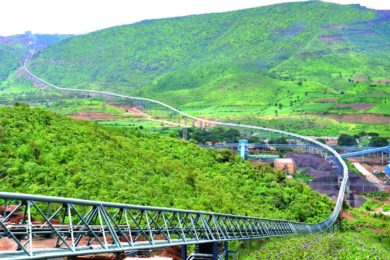One of the article’s in January International Mining examines oil shale mining in Estonia and technologies being advanced top improve extraction. America’s Lawrence Livermore National Laboratory (LLNL) and American Shale Oil (AMSO), have just entered into a technical co-operation agreement to develop carbon sequestration technologies for in-ground shale-oil production processes. Specifically, LLNL will partner with AMSO to study how to use depleted underground oil shale retorts to permanently store carbon dioxide generated during the oil shale extraction process. AMSO will provide technical expertise and oil shale core samples from its federal lease site.
Oil shale can be converted to oil by subjecting it to high temperatures and high pressures – effectively speeding up the geological clock. In early demonstration projects, LLNL researchers used explosives to fracture the vast oil-shale reserves in the western US so that the oil could be processed in place. That effort evolved in the early 1980s into a surface oil-shale retorting process that used hot oil-shale particles as the heat carrier. The research also produced a model of how oil is formed in nature. Today, this model aids the exploration efforts of nearly every major oil company in the world.
The shale that remains in the ground after the oil is extracted could be used as a storage place for the carbon dioxide that is created during the extraction process.
“We’re glad to be working with the impressive staff and capabilities of AMSO to help tackle the key environmental and technical challenges facing domestic oil shale production,” said Julio Friedmann, program leader of LLNL’s carbon management program. “We see this partnership in line with our mission in energy and environmental security for the nation.”
AMSO holds a Research Development and Demonstration (RD&D) lease from the US Bureau of Land Management for a 160-acre parcel of federal land in northwest Colorado’s oil-shale rich Piceance Basin. Upon demonstration of an economically viable, environmentally acceptable extraction process, AMSO has a preference right to acquire a 5,120-acre commercial lease.
After the oil is extracted from shale, the depleted retort of heated, rubblized underground shale may be particularly suitable for capturing carbon dioxide, according to Dr. Alan K. Burnham, AMSO’s Chief Technology Officer. “Together with the Lawrence Livermore National Laboratory, we will explore several interesting approaches to protect the environment by sequestering CO2 through mineralization in retorted oil shale.”
“Lawrence Livermore National Lab is a nationally recognized leader in scientific research on clean energy production”, said AMSO CEO Howard Jonas. “I’m delighted that the Lab will be working with AMSO to develop carbon sequestration approaches for oil shale production. Americans deserve affordable fuels developed using the best available environmental protection technologies.”
AMSO, a subsidiary of IDT Corp, is one of three companies holding a US Bureau of Land Management oil shale research, development and demonstration lease of government-owned lands in the Piceance Basin in northwest Colorado. Its aim is to develop its proprietary technology into a commercially viable and environmentally sound method of producing commercial quantities of shale oil by using in-situ extraction processes. AMSO has developed a multi-phase plan from the initial pilot stage through commercial conversion of the BLM lease.








